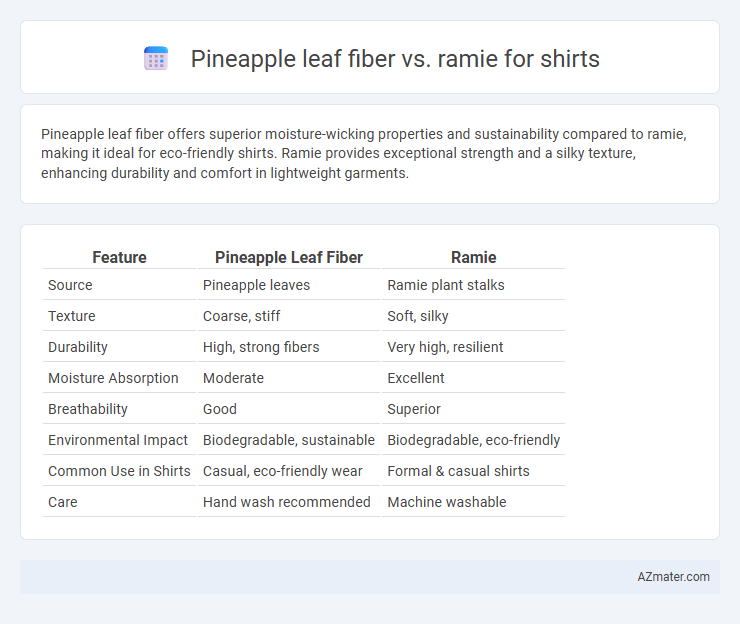Pineapple leaf fiber offers superior moisture-wicking properties and sustainability compared to ramie, making it ideal for eco-friendly shirts. Ramie provides exceptional strength and a silky texture, enhancing durability and comfort in lightweight garments.
Table of Comparison
| Feature | Pineapple Leaf Fiber | Ramie |
|---|---|---|
| Source | Pineapple leaves | Ramie plant stalks |
| Texture | Coarse, stiff | Soft, silky |
| Durability | High, strong fibers | Very high, resilient |
| Moisture Absorption | Moderate | Excellent |
| Breathability | Good | Superior |
| Environmental Impact | Biodegradable, sustainable | Biodegradable, eco-friendly |
| Common Use in Shirts | Casual, eco-friendly wear | Formal & casual shirts |
| Care | Hand wash recommended | Machine washable |
Introduction to Natural Fibers for Shirts
Pineapple leaf fiber and ramie are two natural fibers gaining popularity in sustainable fashion due to their eco-friendly properties and durability. Pineapple leaf fiber is known for its coarser texture and high tensile strength, making it suitable for casual and rugged shirts, while ramie offers a silky luster and smooth feel ideal for lightweight, breathable garments. Both fibers provide biodegradable alternatives to synthetic fabrics, contributing to reduced environmental impact in shirt production.
Overview of Pineapple Leaf Fiber
Pineapple leaf fiber, derived from the leaves of the Ananas comosus plant, offers a sustainable and biodegradable alternative for textile production, particularly in shirts. It is known for its strength, durability, and natural luster, making it a premium choice in eco-friendly fashion. Compared to ramie, pineapple leaf fiber tends to have a coarser texture but excels in moisture absorption and breathability, enhancing wearer comfort.
Overview of Ramie Fiber
Ramie fiber, derived from the stalks of the Boehmeria plant, is known for its exceptional strength and lustrous appearance, making it a popular choice in high-quality shirt production. Its natural resistance to bacteria and molds, combined with excellent breathability, sets Ramie apart from Pineapple leaf fiber, which tends to be coarser and less smooth. Ramie's ability to blend well with other fibers and maintain shape after washing ensures durability and a refined finish in shirts.
Fiber Extraction Processes Compared
Pineapple leaf fiber extraction involves a traditional decortication process where leaves are crushed to separate fibers, followed by washing and drying to enhance softness and durability. Ramie fibers are extracted through retting, where stalks undergo microbial degradation to loosen fibers, then undergo degumming to remove gummy substances for a finer texture. The pineapple method tends to be more labor-intensive but results in coarser fibers suitable for sturdy shirts, whereas ramie extraction produces smoother, lustrous fibers ideal for lightweight, breathable shirts.
Sustainability and Environmental Impact
Pineapple leaf fiber offers a highly sustainable alternative for shirts due to its production from agricultural waste, requiring no additional land, water, or pesticides, which significantly reduces environmental impact. Ramie fiber, while also biodegradable and durable, involves more intensive cultivation practices with higher water and pesticide usage, leading to a larger ecological footprint. Choosing pineapple leaf fiber supports sustainable fashion by minimizing resource consumption and promoting waste valorization in textile production.
Comfort and Wearability
Pineapple leaf fiber offers excellent breathability and moisture-wicking properties, making shirts extremely comfortable in warm climates. Ramie fabric provides a silky texture and high durability with a smooth finish, enhancing wearability for extended periods. Both fibers are lightweight and breathable, but pineapple leaf fiber is notably softer against the skin, while ramie resists wrinkles better for a polished look.
Durability and Longevity
Pineapple leaf fiber boasts remarkable durability due to its high cellulose content, making shirts resistant to wear and tear over extended use. Ramie fabric offers excellent strength and maintains its form well, but it is more prone to brittleness and requires careful laundering to preserve longevity. When selecting between the two, pineapple leaf fiber shirts generally provide superior endurance and longer-lasting performance in everyday wear.
Dyeing and Finishing Properties
Pineapple leaf fiber offers better dye absorption due to its porous structure, resulting in vibrant and long-lasting colors, while ramie provides excellent dye affinity with smooth, glossy finishes that enhance fabric brightness. Pineapple fiber's natural stiffness requires specialized finishing techniques to improve softness and durability in shirts, whereas ramie's strong, lustrous fibers allow for easier mechanical finishing, producing lightweight, breathable garments. Both fibers respond well to eco-friendly dyeing processes, but ramie's superior moisture retention supports more uniform dye uptake and finish stability.
Cost and Market Availability
Pineapple leaf fiber is generally more cost-effective than ramie due to its abundant supply as an agricultural byproduct, leading to lower raw material expenses for shirt production. Ramie, though valued for its silky texture and durability, often commands higher prices because of more intensive processing requirements and limited large-scale cultivation. Market availability of pineapple leaf fiber is expanding rapidly in regions like the Philippines, whereas ramie remains less widespread, primarily produced in parts of China and East Asia, impacting the ease of sourcing for manufacturers.
Final Comparison: Which Fiber Is Better for Shirts?
Pineapple leaf fiber offers exceptional breathability and sustainability, making it ideal for lightweight, eco-friendly shirts, while Ramie provides superior strength, smooth texture, and excellent moisture-wicking properties suitable for durable and luxurious garments. Pineapple fiber's coarser texture requires blending for softness, whereas Ramie's natural silk-like sheen enhances shirt aesthetics without heavy processing. For eco-conscious consumers seeking comfort and durability, Ramie stands out as the better fiber for high-quality shirts, though pineapple leaf fiber remains a strong sustainable alternative.

Infographic: Pineapple leaf fiber vs Ramie for Shirt
 azmater.com
azmater.com